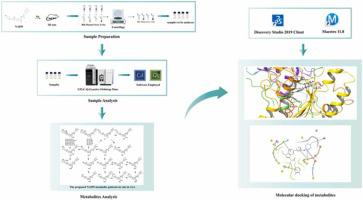溶血磷脂酸 (LPA) 介导的信号传导与肺细胞的纤维化和增殖有关,例如促进成纤维细胞积累和刺激 TGF-β 信号。减少溶血磷脂酸产生的重要机制之一是抑制自粘蛋白活性,这可以阻止溶血磷脂酰胆碱 (LPC) 水解成 LPA,从而缓解肺纤维化的发展。最近,3,4-二氟苄基(1-乙基-5-(4-((4-羟基哌啶-1-基)-甲基)-噻唑-2-基)-1H-吲哚-3-基)氨基甲酸酯(NAI59) , 一种新型的 autotaxin 抑制剂,显示出卓越的抗肺纤维化治疗效果;然而,NAI59的代谢信息尚未得到全面阐述。因此,在本研究中,我们的目标是使用超高效液相色谱 - 高分辨率串联质谱法鉴定大鼠体内 NAI59 的代谢物,并使用与晶体结构 autotaxin 的分子对接来分析血浆中代谢物的潜在抗纤维化作用。结果共鉴定出24种代谢物,即15种I期代谢物和9种II期代谢物,均为新发现的代谢物。NAI59的代谢途径主要是羟基化、氧化、氢化、葡萄糖醛酸结合、硫酸结合、乙酰化和葡萄糖基化。分子对接结果表明,血浆中鉴定的代谢物与autotaxin的活性位点对接后具有很强的亲和力,表明它们可能具有潜在的抗肺纤维化活性。相互作用图揭示了氟苯基和哌啶上的羟基基团的重要性,这些基团有助于与 autotaxin 形成氢键。此外,我们发现当结构中含有葡萄糖醛酸基团时,代谢物具有更好的对接结果。据我们所知,这项研究是对大鼠 NAI59 代谢命运的首次研究,我们使用分子对接分析代谢物潜在的抗纤维化方面。这项研究为进一步的临床前研究提供了代谢原理,并为开发改进的 ATX 抑制剂提供了新的见解。我们发现当结构中含有葡萄糖醛酸基团时,代谢物具有更好的对接结果。据我们所知,这项研究是对大鼠 NAI59 代谢命运的首次研究,我们使用分子对接分析代谢物潜在的抗纤维化方面。这项研究为进一步的临床前研究提供了代谢原理,并为开发改进的 ATX 抑制剂提供了新的见解。我们发现当结构中含有葡萄糖醛酸基团时,代谢物具有更好的对接结果。据我们所知,这项研究是对大鼠 NAI59 代谢命运的首次研究,我们使用分子对接分析代谢物潜在的抗纤维化方面。这项研究为进一步的临床前研究提供了代谢原理,并为开发改进的 ATX 抑制剂提供了新的见解。
 "点击查看英文标题和摘要"
"点击查看英文标题和摘要"
Investigation of novel ATX inhibitor metabolites by UHPLC-orbitrap-MS/MS and molecular docking studies
Lysophosphatidic acid (LPA) mediated signaling is relevant to fibrosis and the proliferation of pulmonary cells, such as the promotion of fibroblast accumulation and stimulation of the TGF-β signal. One of the essential mechanisms to reduce lysophosphatidic acid production is inhibiting autotaxin activity, which can block the hydrolysis of a lysophosphatidylcholine (LPC) into LPA, leading to the alleviation of the development of pulmonary fibrosis. Recently, 3,4-difluorobenzyl(1-ethyl-5-(4-((4-hydroxypiperidin-1-yl)-methyl)-thiazol-2-yl)-1H-indol-3-yl)carbamate (NAI59), a novel autotaxin inhibitor, showed outstanding anti-pulmonary fibrosis therapeutic effectiveness; however, the metabolic information of NAI59 has not been comprehensively expounded yet. Therefore, in this study, we aim to identify the metabolites of NAI59 in rats using ultra-high-performance liquid chromatography-high-resolution tandem mass spectrometry, and we analyze the potential anti-fibrosis of metabolites in plasma using molecular docking with the crystal structure autotaxin. As a result, a total of 24 metabolites, namely, 15 phase I metabolites and 9 phase II metabolites, were identified, all of which are the novel discovered metabolites. The metabolic pathways of NAI59 were primarily hydroxylation, oxidation, hydrogenation, glucuronic acid conjugation, sulfate conjugation, acetylation, and glucosylation. The molecular docking result showed that the identified metabolites in plasma had great affinities upon docking into the active site of autotaxin, indicating they may have potential anti-pulmonary fibrosis activity. The interaction plots revealed the importance of fluorophenyl and the hydroxyl groups on piperidine that contribute toward the formation of hydrogen bonds with autotaxin. Additionally, we found that the metabolite possessed a better docking result when the structure contained a glucuronic acid group. To the best of our knowledge, this study is the first research into the metabolic fate of NAI59 in rats, and we analyze the potential anti-fibrosis aspects of metabolites using molecular docking. This study provides a metabolic rationale for further preclinical research and imparts new insights for developing improved ATX inhibitors.

































 京公网安备 11010802027423号
京公网安备 11010802027423号